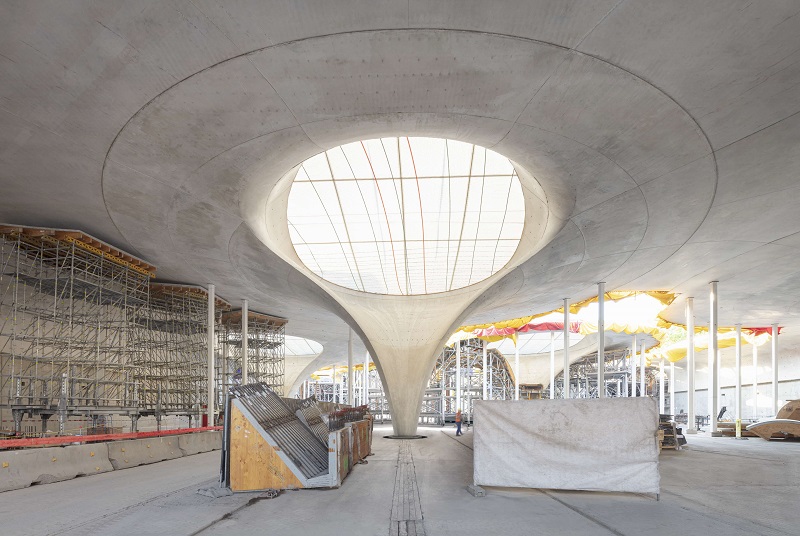How do we build in harmony with the world’s resources? One of the pioneers of sustainable architecture, German architect, Christoph Ingenhoven, challenges us to continue to rethink how we are designing and constructing our buildings for a more sustainable future.
From the RWE Tower, Germany’s first ecological high-rise building, to the Kö-Bogen II office building with over 30,000 plants and Marina One in Singapore, giving back 170 per cent of greenery to the city, what does designing a green building mean to you?
Plants and landscapes play a key role in almost all our projects. Urban green space must be considered an integral aspect of the building that is part of the concept from the outset.
With Kö-Bogen II, we completed Europe’s largest green facade in 2020. Its experimental facade was developed in collaboration with scientists and based on extensive phytotechnological expertise. At Marina One, its “Green Heart” is the central design element. We have gone beyond the fully air-conditioned boxes that (still) dominate the city’s Central Business District to develop a high-rise building typology specifically for Singapore’s humid tropical climate zone.

Marina One is a model in sustainable design, with its organic shape and distinctive louvres. Completed in 2018, it is located in the heart of Singapore’s financial district in Marina Bay; image credit: ingenhoven associates / HGEsch.
I see having more greenery in the city as a crucial part of our urban response to mitigate the increasing impacts of climate change. Green facades can reduce the inner city heat effect and keep our cities from getting too hot in the summer. By storing rainwater, they close the gap in the water cycle and relieve the burden on the municipal sewerage system during heavy rainfall. They bind carbon dioxide and dust, absorb noise, support biodiversity, and foster our overall wellbeing.
The more fundamental questions are – What is the right way to build under the conditions we live in today? How do we build in harmony with the world’s resources? We know we consume too much – global human consumption accounts for 170 per cent of our planet’s resources. This means that our overall ecological footprint is 1.7 times as large as the Earth’s biocapacity, which is the capacity of our planet’s ecosystems to produce useful biological materials and absorb human-generated waste.
In Germany, for example, with our high standard of living, we consume 2.7 times as much as our planet’s biocapacity. We all know that the construction industry accounts for about 60 per cent of global resource consumption.
Given these figures and a growing world population, if not radical renunciation, what are our alternatives?

Kö-Bogen II, the two-part commercial and office building in Germany was completed in 2020. It has one of the largest green facades in Europe. Image credit: ingenhoven associates / HGEsch.
You developed and copyrighted the concept and term, supergreen®. Tell us more about what this means.
Designing sustainable buildings is something I’ve thought about from the very beginning as a way to make a difference as an architect. Our supergreen® concept sums up our approach at ingenhoven associates – a holistic system of insights and demands that is constantly evolving.
Over 20 years ago, we looked to concepts such as self-sufficiency – the idea that everything you need is produced on your own property – to help articulate our priorities. We first worked on optimising the energy needed to operate buildings. Then we included the influences of the occupants and users, and now we focus on the material cycles and the recyclability of construction materials.
Today, of course, we also consider the grey emissions that occur during the construction of buildings, the production of building materials and components, the transportation and storage of materials, etc.
Even if some of our earlier concepts are no longer relevant, there is no need to wait until all our questions have been conclusively answered. It’s important to take risks and try things out, even if the circumstances are not ideal, in order to learn and to share these new insights with others.
What are the elements of a well-designed green building?
Good architecture can’t be expressed as a simple formula. Nevertheless the parameters of our supergreen® concept illustrates what a well-designed green building should have – climate neutrality, resource reduction, replacement, public spaces, resilience, pandemic proof, inclusion, and urban greenery. Let’s elaborate on some of them.
Climate neutrality – Buildings should aim to emit as few greenhouse gases as possible during the construction and operation of buildings and this is possible with significantly reduced material consumption and if the materials used have a low CO2 footprint and are part of a consistent circular economy and if buildings are operated exclusively with renewable energies, etc. From the perspective of climate neutrality alone, we need to completely rethink our approach to construction.

The Marina One development has over 350 different types of trees and plants, including 700 trees, on a landscaped area of 37,000 square metres. Image credit: ingenhoven associates / HGEsch.
Replacement – We must be conscious of the fact that with every surface we use for construction, we remove some of the Earth’s biocapacity – no matter how sophisticated our buildings are. Singapore has a 100 per cent Landscape Replacement Area policy. For every square metre of land that is built on, one square metre of greenery must be created within the site. Additionally, at least 25 per cent of the built footprint must be public space, and it must be covered to protect against the heavy monsoons. When will a similar landscape replacement law be introduced in Germany or other countries in Europe?
Resilience – The ability of an ecosystem not to collapse in the face of disruption but to maintain its essential functions is something that needs more attention in architecture. Unavoidable consequences of global warming, such as torrential rainfall or extremely hot summers, can be absorbed by buildings. We have solutions that include smart shading systems, green roofs, and green facades.

Once completed in 2025, the roof of the new Stuttgart station will become a completely pedestrian area that meets and extends the nearby Schlossgarten Park. Image credit: ingenhoven associates / HGEsch.
The redevelopment and design of Stuttgart’s central rail station sets new standards with its integration into the urban fabric and the creation of green spaces as well as public areas. Tell us more about the design.
This future central station is part of the Stuttgart 21 transport and urban development project, which is seeing one of the largest enhancements to the public rail transport in Europe since the 19th century. The redevelopment of this main station will significantly reduce travel and transfer times for long-distance and regional traffic. As a light-flooded, low-lying, eight-track through station, it will replace the previous 16-track terminus station.
We designed a unique roof supported by 28 chalice-shaped columns made of white exposed concrete form, which creates a light-flooded underground station concourse. With their free-flowing, dynamic forms, they shape the spatial and sensual qualities of the station. The chalice supports are open at the top to form a circular skylight covered by a steel and glass structure. These “light eyes” fill the hall with natural daylight and reduce the need for energy-consuming artificial lighting.

The unique roof of the Stuttgart station is a complex construction that works only under compression to reduce its thickness and the amount of steel needed. The 28 curved surfaces efficiently follow the course of the forces. Image credit: ingenhoven associates / HGEsch.
We designed the new underground station concourse to maintain a comfortable climate without the need for additional air conditioning, which causes no energy consumption for cooling, heating, lighting during daytime and ventilation. The relatively few glass openings, tunnel airflow – which stays around 15 degrees celsius all year round – and surrounding soil will keep the hall from becoming too hot in summer and too cold in winter. Photovoltaic modules installed on the roof of the historic Bonatz building will generate energy for the facility’s lighting at night.
Beyond this main station design, the above-ground rail facilities in the city centre will be dismantled, creating space for new urban developments, such as housing, offices, including public and park spaces, extending the existing Schlossgarten park with a new green space above the station.
You have said that “the future lies in building high-density, mixed cities”. How can we continue to create liveable and delightful living spaces even in denser environments?
A dense city is energetically much more vibrant and lively compared to a flat and vast one. We have already gone past the car-centred phase of urban development of 30 years ago. Given the world’s growing population and our increasingly more complex needs, our cities must become denser.
But that also threatens to reduce the public space. Architects have a duty to create and protect public spaces through the way they design their projects. We can have denser cities that are highly liveable by designing walkable streets for people, creating a wide array of public plazas and spaces for connection and spontaneous encounters and opening up the ground floors of our buildings for more street life.

Kö-Bogen II extends the greenery of the adjoining Hofgarten park into the inner city. The facades of the main building and the sloping roof at a height of 27 metres are all planted. The profuse facade vegetation provides natural cooling, reduces the inner-city heat effect, and helps to clean and humidify the air. Image credit: ingenhoven associates / HGEsch.
What do you see are the roles of architects in shaping cities? What do you find most satisfying about your work?
Architects should think more about repositioning themselves and be more conscious about who they work for. There is a global need for a very different attitude. We need to raise the bar and find approaches that might seem impossible today. This is not something to be afraid of. We must demand higher standards from the industry and ourselves.
Energy-positive buildings are only a first step and not the only important thing in architecture, but at least it’s a start. I find it deeply satisfying to be able to drive such efforts in exploring new possibilities in shaping a more sustainable and liveable future and build beautiful, good examples.
About Christoph Ingenhoven
Christoph is one of the leading international architects committed to sustainable and ecological architecture. In 1985, he founded the architectural practice ingenhoven associates. The office received international acclaim in 1997 with the RWE Tower in Essen, one of the first ecological high-rise buildings worldwide. Since 1997, ingenhoven associates have been planning the Stuttgart underground central station as the centerpiece of the Stuttgart 21 transportation and urban design project. The practice has developed several excellent high-rise projects in Singapore, Japan and Australia. In 2020, ingenhoven associates completed the Kö-Bogen II, the conclusion of an extensive urban renewal project in the heart of Düsseldorf including Europe’s biggest green façade.
He is a jury member of the Architecture Panel for the 2023 President*s Design Award. It is Singapore’s highest honour for designers and designs across all disciplines. For more information about the award, go to https://pda.designsingapore.org/presidents-design-award/
___
Thumbnail image credit: ingenhoven associates / HGEsch.


